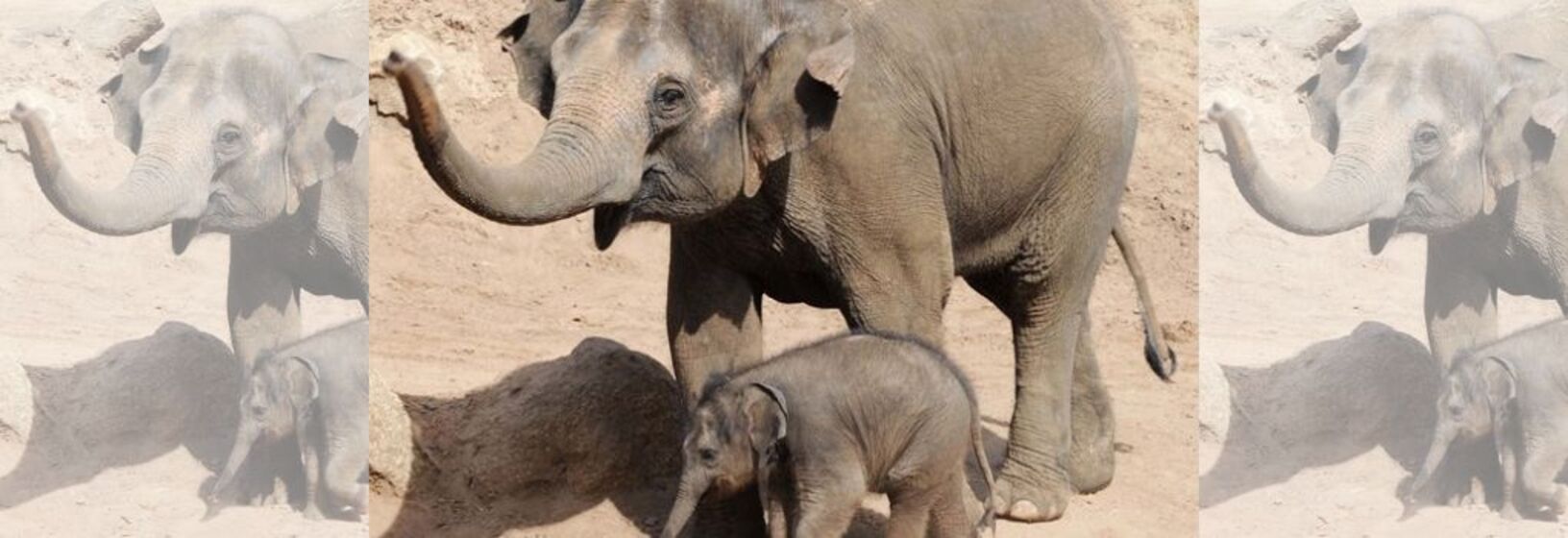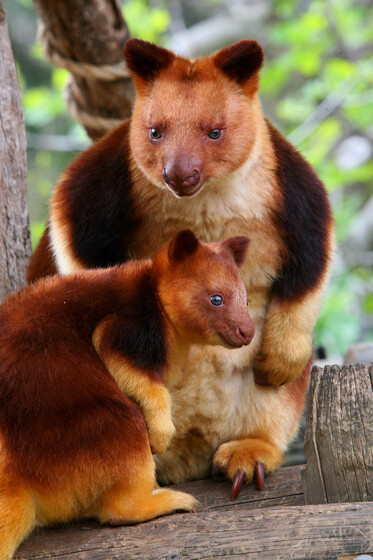See story for image details
Reuse this media
Can you reuse this media without permission? No (with exceptions, see below)
Conditions of use
All rights reserved
This media item is licensed under "All rights reserved". You cannot share (i.e. copy, distribute, transmit) or rework (i.e. alter, transform, build upon) this item, or use it for commercial purposes without the permission of the copyright owner. However, an exception can be made if your intended use meets the "fair dealing" criteria. Uses that meet this criteria include research or study; criticism or review; parody or satire; reporting news; enabling a person with a disability to access material; or professional advice by a lawyer, patent attorney, or trademark attorney.
Attribution
Please acknowledge the item’s source, creator and title (where known)
Photograph - Trent Browning, 'Goodfellow's tree kangaroo: ambassador for the Tenkile Conservation Alliance program', Melbourne Zoo Archives
Courtesy of Zoos Victoria
Reuse this media
Can you reuse this media without permission? No (with exceptions, see below)
Conditions of use
All rights reserved
This media item is licensed under "All rights reserved". You cannot share (i.e. copy, distribute, transmit) or rework (i.e. alter, transform, build upon) this item, or use it for commercial purposes without the permission of the copyright owner. However, an exception can be made if your intended use meets the "fair dealing" criteria. Uses that meet this criteria include research or study; criticism or review; parody or satire; reporting news; enabling a person with a disability to access material; or professional advice by a lawyer, patent attorney, or trademark attorney.
Attribution
Please acknowledge the item’s source, creator and title (where known)
© Copyright of Zoos Victoria
Courtesy of Zoos Victoria
The Goodfellow's tree kangaroo is classified as endangered, with its numbers declining in the wild in Papua New Guinea. They are ambassador animals for Zoos Victoria's Tenkile Conservation Alliance program.
Melbourne Zoo’s transformation into a conservation organisation is demonstrated by its commitment to fighting extinction both inside and outside the zoo walls.
The Zoo aims to be the world’s leading zoo-based conservation organisation through captive holding, breeding and management of native threatened species, as well as conservation programs based in six other countries. Melbourne Zoo also participates in international breeding programs and community conservation campaigns, as well as focusing education and research projects on conservation objectives.
The Zoo’s conservation campaigns raise awareness about wildlife issues and encourage people to take action to assist animals around the world. These campaigns range from donating mobile phones to reduce the need for coltan mining, to supporting mandatory labelling of palm oil.
Further information: Zoos Victoria: fighting extinction goal
Photograph - Trent Browning, 'Sumatran tigers at Melbourne Zoo', Melbourne Zoo Archives
Courtesy of Zoos Victoria
Reuse this media
Can you reuse this media without permission? No (with exceptions, see below)
Conditions of use
All rights reserved
This media item is licensed under "All rights reserved". You cannot share (i.e. copy, distribute, transmit) or rework (i.e. alter, transform, build upon) this item, or use it for commercial purposes without the permission of the copyright owner. However, an exception can be made if your intended use meets the "fair dealing" criteria. Uses that meet this criteria include research or study; criticism or review; parody or satire; reporting news; enabling a person with a disability to access material; or professional advice by a lawyer, patent attorney, or trademark attorney.
Attribution
Please acknowledge the item’s source, creator and title (where known)
© Copyright of Zoos Victoria
Courtesy of Zoos Victoria
Melbourne Zoo has joined the fight to save the Sumatran tiger from extinction through a captive breeding program and the Don’t Palm Us Off initiative.
The Sumatran tiger is critically endangered, with numbers in the wild estimated to be in the hundreds. A major reason for the decline in numbers is that their natural habitat on the Indonesian island of Sumatra is being cleared to make way for palm oil plantations.
Photograph - Trent Browning, 'Sumatran tigers at Melbourne Zoo', Melbourne Zoo Archives
Courtesy of Zoos Victoria
Reuse this media
Can you reuse this media without permission? No (with exceptions, see below)
Conditions of use
All rights reserved
This media item is licensed under "All rights reserved". You cannot share (i.e. copy, distribute, transmit) or rework (i.e. alter, transform, build upon) this item, or use it for commercial purposes without the permission of the copyright owner. However, an exception can be made if your intended use meets the "fair dealing" criteria. Uses that meet this criteria include research or study; criticism or review; parody or satire; reporting news; enabling a person with a disability to access material; or professional advice by a lawyer, patent attorney, or trademark attorney.
Attribution
Please acknowledge the item’s source, creator and title (where known)
© Copyright of Zoos Victoria
Courtesy of Zoos Victoria
In 2010 tiger cubs Aceh, Hutan, Indrah and Rani were born at the Melbourne Zoo as part of an international endangered species breeding program. At present there are more tigers in zoos around the world than there are in the wild.
Further information: Zoos Victoria: Sumatran tiger
Photograph - 'Asian elephants: Mali and her mother Dokkoon at Melbourne Zoo', Melbourne Zoo Archives
Courtesy of Zoos Victoria
Reuse this media
Can you reuse this media without permission? No (with exceptions, see below)
Conditions of use
All rights reserved
This media item is licensed under "All rights reserved". You cannot share (i.e. copy, distribute, transmit) or rework (i.e. alter, transform, build upon) this item, or use it for commercial purposes without the permission of the copyright owner. However, an exception can be made if your intended use meets the "fair dealing" criteria. Uses that meet this criteria include research or study; criticism or review; parody or satire; reporting news; enabling a person with a disability to access material; or professional advice by a lawyer, patent attorney, or trademark attorney.
Attribution
Please acknowledge the item’s source, creator and title (where known)
© Copyright of Zoos Victoria
Courtesy of Zoos Victoria
In 2006 Melbourne Zoo established the Cooperative Conservation Breeding Program upon the arrival of three young female elephant cows from Thailand.
Due to poaching and habitat destruction, it is estimated that the Asian elephant population is fewer than 53 000 in the wild, with numbers continuing to decrease.
Two elephant calves have been born at Melbourne Zoo since 2010. Mali and her younger brother Ongard are now major attractions for visitors.
Further information: Zoos Victoria: Asian elephant
Photograph - Rohan Cleave, 'Lord Howe Island stick insect', Melbourne Zoo Archives
Courtesy of Zoos Victoria
Reuse this media
Can you reuse this media without permission? No (with exceptions, see below)
Conditions of use
All rights reserved
This media item is licensed under "All rights reserved". You cannot share (i.e. copy, distribute, transmit) or rework (i.e. alter, transform, build upon) this item, or use it for commercial purposes without the permission of the copyright owner. However, an exception can be made if your intended use meets the "fair dealing" criteria. Uses that meet this criteria include research or study; criticism or review; parody or satire; reporting news; enabling a person with a disability to access material; or professional advice by a lawyer, patent attorney, or trademark attorney.
Attribution
Please acknowledge the item’s source, creator and title (where known)
© Copyright of Zoos Victoria
Courtesy of Zoos Victoria
Melbourne Zoo has played a vital role in the conservation and recovery of the Lord Howe Island stick insect.
The Lord Howe Island stick insect population was decimated by introduced rats in 1918. The insect was rediscovered in 2001 by rock climbers on Ball’s Pyramid, a sea stack 23km from the island.
Melbourne Zoo has bred over 9000 of these insects, known as ‘land lobsters’, and sent individuals to other institutions both nationally and globally for breeding and display.
Further information: Zoos Victoria: Lord Howe Island stick insect
Photograph - John Lane, 'Southern corroboree frog', Melbourne Zoo Archives
Courtesy of Zoos Victoria
Reuse this media
Can you reuse this media without permission? No (with exceptions, see below)
Conditions of use
All rights reserved
This media item is licensed under "All rights reserved". You cannot share (i.e. copy, distribute, transmit) or rework (i.e. alter, transform, build upon) this item, or use it for commercial purposes without the permission of the copyright owner. However, an exception can be made if your intended use meets the "fair dealing" criteria. Uses that meet this criteria include research or study; criticism or review; parody or satire; reporting news; enabling a person with a disability to access material; or professional advice by a lawyer, patent attorney, or trademark attorney.
Attribution
Please acknowledge the item’s source, creator and title (where known)
© Copyright of Zoos Victoria
Courtesy of Zoos Victoria
Since 2001 Melbourne Zoo has been committed to fighting the extinction of the southern corroboree frog.
Disease and climate change have been major causes of the decline of the southern corroboree frog. It is thought that there are as few as ninety of these amphibians in the wild.
Melbourne Zoo maintains a captive insurance population of southern corroboree frogs. The zoo also coordinates a breeding program for release of these frogs into wild populations. They conduct research into infectious chytrid fungus disease which affects the southern corroboree frog.
Further information: Zoos Victoria: southern corroboree frog
Photograph - 'Eastern barred bandicoot', Melbourne Zoo Archives
Courtesy of Zoos Victoria
Reuse this media
Can you reuse this media without permission? No (with exceptions, see below)
Conditions of use
All rights reserved
This media item is licensed under "All rights reserved". You cannot share (i.e. copy, distribute, transmit) or rework (i.e. alter, transform, build upon) this item, or use it for commercial purposes without the permission of the copyright owner. However, an exception can be made if your intended use meets the "fair dealing" criteria. Uses that meet this criteria include research or study; criticism or review; parody or satire; reporting news; enabling a person with a disability to access material; or professional advice by a lawyer, patent attorney, or trademark attorney.
Attribution
Please acknowledge the item’s source, creator and title (where known)
© Copyright of Zoos Victoria
Courtesy of Zoos Victoria
Since 1991 Zoos Victoria have bred nearly 600 eastern barred bandicoots as part of their captive breeding program and helped establish three small reintroduced populations in the wild.
Eastern barred bandicoots were thought to be extinct until 1991 when a small population was found living at the Hamilton tip in western Victoria. Habitat destruction and introduced predators such as cats and foxes have significantly contributed to the decline in Eastern barred bandicoot numbers.
Further information: Zoos Victoria: eastern barred bandicoot










